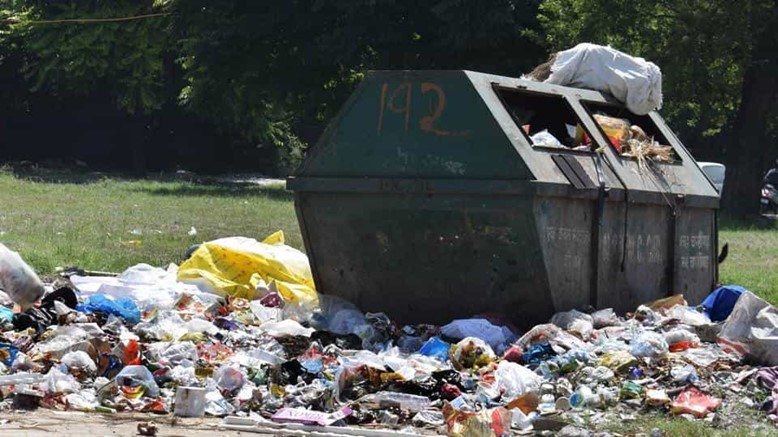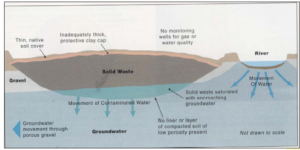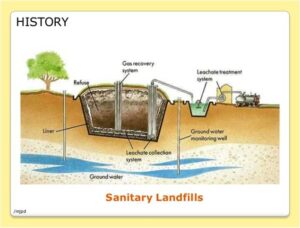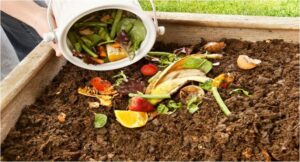Disposal of municipal Solid Waste techniques

Disposal of municipal solid waste
1. Dumping
2. Landfill
3. Controlled Tipping or Sanitary Landfill
4. Incineration
5. Composting
6. Pyrolysis
1. Dumping (Open dumping)
- In this method waste materials are dumped in open lowlands far away from the city this method is not environment friendly
- However, this is the cheapest method and does not require much planning
- The open pits spoil the site of the area and become a breeding ground for mosquitoes, flies, insects, etc that are the carriers of harmful diseases
- They give out a foul odor.
- The burning of waste material in the open dumps pollutes the air
2. Natural Landfill
Generally located in urban areas where large amount of waste is generated and has to be dumped in a commonplace. Unlike open dump, it is a pit that is dug in the ground. The garbage is dumped and pit is covered thus preventing the breeding of flies and rats. At the end of each day, a layer of soil is scattered on top of it and some mechanism, usually, a piece of earth-moving equipment is used to compress the garbage. After the landfill is full the area is covered with a thick layer of mud and the site can thereafter be developed as a parking lot or a park.

Problem with Landfill
Landfills have many problems, All type of waste is dumped in landfill and when water seeps through them it gets contaminated and in turn pollutes the surrounding area. This contamination of groundwater and soil through landfill is known as leaching.
3. Sanitary Landfill
- An alternative to landfills that will solve the problem of leaching to some extent is a sanitary landfill which is more hygenic and built in a methodical manner.
- These are lined with materials that are impermeable such as plastics and clay and are also built over impermeable soil.
- Constructing sanitary landfill is very costly and they have their own problems.
- It can be referred to as a safer and more organized system or way of waste management. It is regulated by the Government and must strictly follow certain laws and processing regulations for waste treatment.
- In this waste is packed and dumped at the site and is covered with earth daily to prevent insects or rodents from entering the landfill
- The bottom of the pit also has a liner that helps in preventing the liquid waste (that comes out from the solid waste mostly if rainwater is soaked in the landfill) from leaking through, as it could contaminate the water supply.
- This liquid waste that gets collected is called leachate.
- When the landfill is fully covered, it is further sealed by a layer of compacted clay. Moreover, a gas (methane) is often produced as the waste deteriorates due to which a system is required to collect and pump the same
- If this is not managed effectively, the methane gas can explode, thus adding to global warming. Furthermore, the methane gas in most places is collected for use in generating electricity.

Problems with Sanitary Landfill
- Large area requirements
- Extensive monitoring requirements
- Post-disposal maintenance requirements
- Land remains abandoned for long durations
- Contamination of the ground and surface water resources in case of natural calamities like geological phenomena, floods, etc.
Sanitary Landfill Advantages and Disadvantages
ADVANTAGES
- Landfill site is a cheap waste disposal option for the local council.
- Jobs will be created for local people.
- Lots of different types of waste can be disposed of by landfill in comparison to other waste disposal methods.
- The gases given off by the landfill site could be collected and used for generating power.
DISADVANTAGES
- The site will look ugly while it is being used for landfill.
- Dangerous gases are given off from landfill sites that cause local air pollution and contribute to global warming.
- Local streams could become polluted with toxins seeping through the ground from the landfill site.
- Once the site has been filled it might not be able to be used for redevelopment as it might be too polluted.
4. Incineration
- In these plants, the recyclable material is segregated and rest of the material is burnt .
- At the end of the process, all that is left behind is ash. During this process, some of the ash floats out with the hot air.This is called fly ash.
- Both the Fly ash and the ash that is left in the furnace after burning have high concentrations of dangerous toxins such as dioxins and heavy metals.
- At present incineration is kept as the last resort and is used mainly for treating infectious waste.
- Burning garbage is not a clean process as it produces tonnes of toxic ash and pollutes the air and water
- Incineration is a waste treatment process that involves the combustion of solid waste at 1000C.
- waste materials are converted into ash, flue gas, and heat.
- the heat generated by incineration is used to generate electric power.
Advantages and Disadvantages of Incineration
- A minimum of land is needed compared to other disposal methods.
- The weight of the waste is reduced to 25% of the initial value.
- No risk of polluting local streams and ground waters as in landfills.
- Incineration plants can be located close to residential areas.
- Gases are used to generate power.
DISADVANTAGES
- Expensive
- Required skilled labor.
- The chemicals that would be released into the air could be strong pollutants and may destroy ozone layer (a major disadvantage).
- high energy requirement.
5. Composting
Composting is the process of aerobic decomposition of organic matter in solid waste by bacteria and fungi.
To ensure a reasonable composting rate, the following parameters are to be maintained.
- Temperature :25-50 degree celcius
- pH:5-8
- Moisture:50-70%
- Natural composting is carried out under existing environmental conditions. In mechanized composting units, controlled conditions are maintained. The material to be composed has to be segregated remove non-biodegrable materials like glass, plastics and metals and alloys. A proper mix of nutrients like animal waste, and sewage sludge is necessary to ensure the proper growth of bacteria and fungi.
Steps involved in composting involves three stages :
- Removing non –compostable materials –It is the initial preparatory step that involves the preparation of materials like tins cans, bottles or cans of plastic, while the rest is shredded into particles and melted.
- Spreading composted material- the composted material is spread in long rows of small heaps and dried for several weeks. Temperature and humidity combined with frequent aeration are critical factors for good composting.
- Seeking Microbial help: Bacteria and fungi convert the organic wastes in presence of air and heat to compost. Completely mature and stable compost does not produce a putrid smell of sewage or refuse
Composting is one of the oldest forms of disposal. It is the natural process of decomposition of organic waste that yields manure or compost, which is very rich in nutrients
- A biological process in which microorganisms, mainly fungi and bacteria, convert degradable organic waste into humus like substances.
- This finished product which look like soil is high in carbon and nitrogen and is an excellent medium for growing plants.
- The microorganism help to stabilize the organic matter. For example, fungi start working in the first week after dumping of the material. Actinomycetes help in the last stages of the breakdown while bacteria is present throughout the process.
- In India, both the manual as well as mechanical methods of composting are used.
- In rural areas composting refuse and soil mixtures are dumped together which produces manure for the fields. Layers of vegetable waste and soils are alternated in a shallow hole dug in the ground.

- The mixture is turned regularly for about three months to provide air to the mixture. Then the compost is left for another month without turning for the process to take effect. This method is known as the Indore method
- In the mechanical process, used in Bengaluru and adopted by the other cities in the country, the waste material is placed in layers about one meter deep. The material is not turned at all but it decomposes completely in about five months. This method of composting is known as Bangalore Method.

6. Pyrolysis
- Pyro = heat. Lysis = break down. Pyrolysis is a chemical reaction. This reaction involves the molecular breakdown of larger molecules into smaller molecules in presence of heat. Pyrolysis is also known as thermal cracking, cracking, thermolysis, depolymerization, etc.
- The solid wastes are heated to very high temperatures (600-800 degrees Celcius)but in very sparse air or oxygen so that they do not burn completely but only smolder.
- The pyrolysis product resembles to that of charcoal.
- Rubber tires and synthetic polymers etc when burnt produce extremely polluting smoke posing air pollution
- This method does not reduce the waste bulk to a pittance like incineration
Recovery of Resources
Useful products can be recovered from the waste. For Example :
1. Converting waste into biogas: Biogas research and development program aims in enhancing the bio-digesting of cattle dung and numerous organic wastes which severely pollute the soil. The production of biogas from waste is not so simple as large varieties of microorganisms are involved in a synchronized manner to generate methane which is the main inflammable component of biogas.
Recently scientists have designed a biogas unit to utilize the waste. The digested slurry can be used as enriched manure in agriculture, pisciculture and mushroom cultivation, etc. value-added utilization of manure has been taken up at Bhartiya Agro industries foundation (BAIF) Pune: central food technological research institute (CFTRI) PAU Ludhiana
- Sanitation: Human waste for manure purposes can be used if pour-flush toilets are linked with biogas units. The ministry of non-conventional energy sources (MNES) is providing either a central subsidy a turn-key job fee for constructing a toilet and attaching it with a biogas unit. About 95000 sanitary toilets are linked with biogas unit in India by the states of Maharashtra, West Bengal, and Gujarat.
3. Meeting heat energy demands: Energy provides used with a capacity to do useful work , it has generally been drawn from three types of sources
1. Fossil Fuels i.e. Coal, oil, natural gas, etc
2. Biological Sources – Vegetable wastes, cattle dung, wood, etc.
- Electricity is generated from hydro, nuclear and thermal resources.
To Read about Solid Waste click here.
To Read about HAZARDOUS WASTE: MANAGEMENT AND TREATMENT click here.




